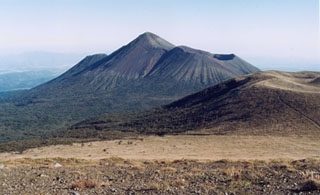Report on Kirishimayama (Japan) — 21 May-27 May 2025
Smithsonian Institution / US Geological Survey
Weekly Volcanic Activity Report, 21 May-27 May 2025
Managing Editor: Sally Sennert.
Please cite this report as:
Global Volcanism Program, 2025. Report on Kirishimayama (Japan) (Sennert, S, ed.). Weekly Volcanic Activity Report, 21 May-27 May 2025. Smithsonian Institution and US Geological Survey.
Kirishimayama
Japan
31.934°N, 130.862°E; summit elev. 1700 m
All times are local (unless otherwise noted)
The Japan Meteorological Agency (JMA) reported that increased unrest at Shinmoedake (Shinmoe peak, a stratovolcano of the Kirishimayama volcano group) during March through early May had stabilized. Volcanic earthquakes with epicenters beneath Shinmoedake began to increase on 28 March and tiltmeter data indicated inflation on 30 March. During 22-26 April minor NW tilt was observed in inclinometer data and the number of earthquakes further increased. Volcanic tremor was detected on 27 April and during 1-2 May. During the first half of May seismicity remained high but did not significantly increase, and there were no changes detected in tiltmeter data. At 1100 on 27 May the Alert Level was lowered to 2 (on a 5-level scale) and the public was warned to exercise caution within 2 km from Shinmoedake Crater.
Geological Summary. Kirishimayama is a large group of more than 20 Quaternary volcanoes located north of Kagoshima Bay. The late-Pleistocene to Holocene dominantly andesitic group consists of stratovolcanoes, pyroclastic cones, maars, and underlying shield volcanoes located over an area of 20 x 30 km. The larger stratovolcanoes are scattered throughout the field, with the centrally located Karakunidake being the highest. Onamiike and Miike, the two largest maars, are located SW of Karakunidake and at its far eastern end, respectively. Holocene eruptions have been concentrated along an E-W line of vents from Miike to Ohachi, and at Shinmoedake to the NE. Frequent small-to-moderate explosive eruptions have been recorded since the 8th century.

